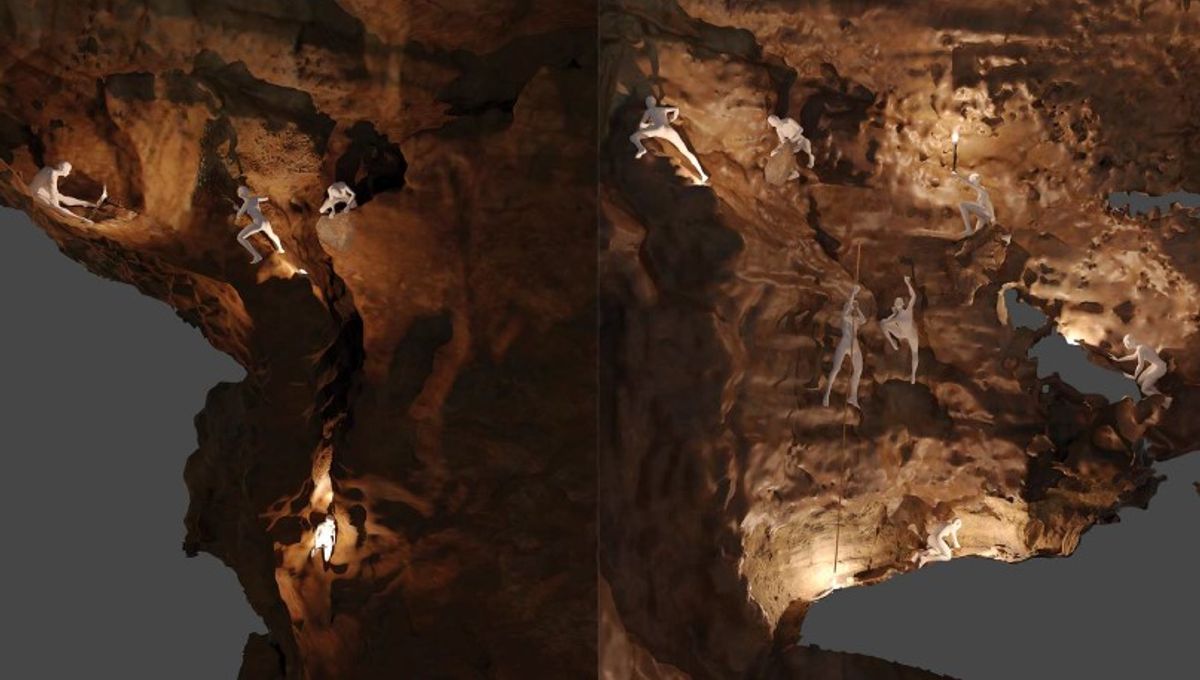
Prehistoric paintings found deep inside a perilously inaccessible cave in the French Pyrenees reveal how ancient hunter-gatherers risked their necks to conduct ritual activities in the bowels of the Earth. Known as Etxeberri Cave, the site is considered one of the most challenging caverns to have been explored by Palaeolithic humans, and may have been decorated as part of a death-defying initiation undertaken by aspiring shamans.
Analyzing the pathways by which these ancient cavers navigated the subterranean site, the authors of a new study have reconstructed the various challenges that had to be overcome in order to reach the innermost sections of the cave, where many of the artworks are found. Dated to around 16,000 years ago, these Stone Age paintings were produced using red ocher, black charcoal, and brown clay, and depict animals such as horses and bison as well as human figures and abstract symbols.
Aside from squeezing through incredibly narrow passages and descending a series of vertical walls, these prehistoric spelunkers also had to cross “an extremely exposed ledge” overlooking a sheer 16-meter (52-foot) drop known as the “Sinkhole of the Angel”. “The main drop is 16 meters, but actually it continues falling for 60 meters [197 feet],” says study author Iñaki Intxaurbe. “So it’s very dangerous,” he told IFLScience.
Unsurprisingly, the researchers write that “a single misstep would have been fatal without some form of support, such as a rope.” However, because cords made of plant fibers tend to decompose relatively quickly, any climbing ropes that may have been used in Etxeberri Cave have long since disappeared, making it impossible to confirm whether these ancient explorers made use of this technology.
“As for lighting, conifer wood [such as pine] and burnt bone were used as fuel,” write the authors. “They also used animal fat which could be introduced into a hole in a small stone or piece of wood to produce torches or lamps,” says Intxaurbe.
At the same time, the researchers found flint tools that appear to have been used to chisel away the rock in order to open up narrow passages or clear obstacles. According to Intxaurbe, this suggests that prehistoric cavers essentially developed “the same technology that we use nowadays in caving”, only in a more primitive form.
As for the bigger question of why these ancient hunter-gathers risked it all to leave their mark on the walls of this treacherous cave, the authors say the nature of the images may provide a clue. For instance, while the most easily accessible part of the cave is decorated with larger, finer artworks, the deeper and more unreachable sections contain less refined paintings.
Intxaurbe therefore speculates that the former may represent “public” images, produced by a shaman for use in collective rituals. The latter, meanwhile, might be the work of “students, like children or juveniles who would become shamans in the future but had to undertake a rite of passage to reach these difficult places and make these [artworks].”
“So the entire cave may have been used like a training place for future shamans,” he says, while insisting that this is simply a hypothesis.
And while it’s currently impossible to verify this theory, we do at least know that none of these supposed apprentices made a fatal misstep. “We haven’t found any human remains inside Etxeberii,” says Intxaurbe. “So they succeeded, at least, in exiting the cave.”
The study is published in the Journal of Field Archaeology.
Source Link: 16,000-Year-Old Paintings Suggest Prehistoric Humans Risked Their Lives To Enter “Shaman Training Cave”